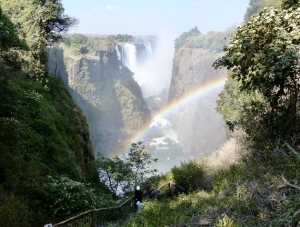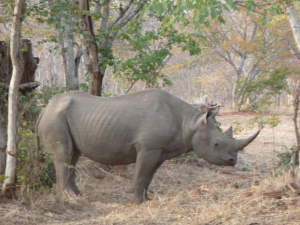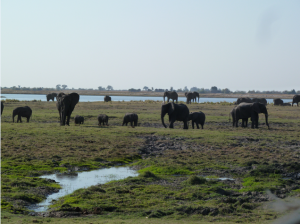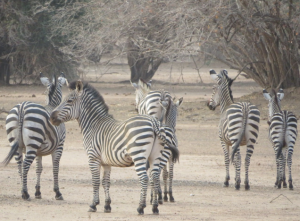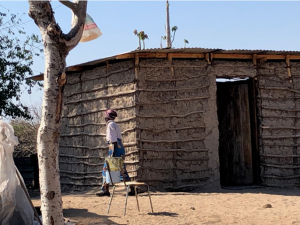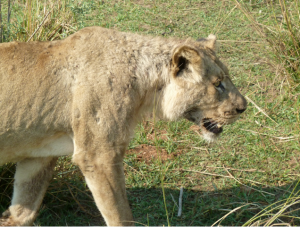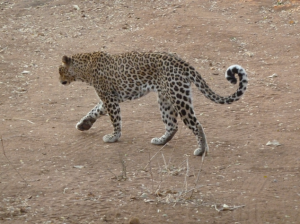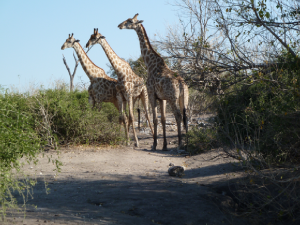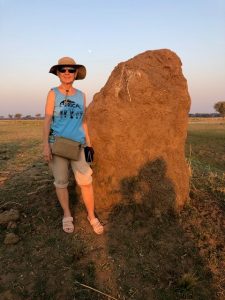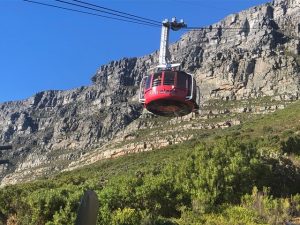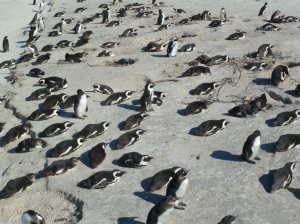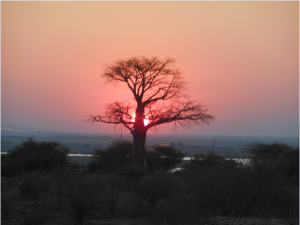This summer, longtime OLLI Advisory Board Member Lisa Troute participated in an amazing African safari adventure. We enjoy hearing about spectacular travels from our OLLI students and wanted to share Lisa’s journey.
By: Lisa Troute, OLLI Advisory Board Member
Africa! The Dark Continent, full of mystery and wonder, and so alluring. I responded to that allure in August, beginning my journey with Odysseys Unlimited Tours in Johannesburg, South Africa. “Joburg,” as it is known, is called the “City of Gold,” after the gold rush they had there. It is South Africa’s largest and most diverse metropolis and is now a bustling travel destination.
There were 20 in our group, and we toured Johannesburg’s infamous district of Soweto. Originally a collection of townships established by segregationists in the early 20th century to house black laborers, the “Southwest Townships” (from which the “Soweto” acronym derived) were the site of some of South Africa’s most visible and violent anti-apartheid riots. After decades of civil unrest, and the eventual repeal of apartheid in the late 1990s, Soweto has now turned into a sprawling residential area with dwellings ranging from crude corrugated metal structures with rocks to hold down roofs, to brick and mortar homes. There we saw the home of former Archbishop Desmond Tutu and visited Nelson Mandela’s home, now a museum. It still bore scars from the Molotov cocktails that had been thrown at it.
We also visited the Hector Pieterson Memorial & Museum – a monument to the Soweto uprising which figured prominently in the struggle against apartheid. It was here that 13-year-old Hector was among those young students shot and killed in June, 1976 while protesting the government’s order that school instruction be delivered in Afrikaans despite the fact that most teachers weren’t comfortable with that language. We met a local Sowetan, Antoinette, Hector’s sister, and listened to her personal stories, both of her participation in the Soweto uprising and death of her brother, and of what life is like today in this township. It seems that even the mourners attending the funerals of those slain in 1976 were shot at (and some were killed) during graveside services for their loved ones.
A flight brought us to Victoria Falls (Zimbabwe) and our historic hotel, The Victoria Falls Hotel, built by the British in 1904, and where the people from Downton Abbey would have felt quite at home. The hotel sits less than two miles from the mighty Victoria Falls. The entire town was built to the support the hotel, and grew from there into a tourist destination. Victoria Falls, called “the smoke that thunders” by the natives, was first encountered in 1855 by explorer David Livingstone. As the first European said to have set eyes on the falls, Livingstone immediately claimed them for Britain’s Queen Victoria. With its 300-foot deep gorge and thundering spray, “Vic” Falls is a wonder of the natural world, a UNESCO World Heritage site, and the world’s largest waterfall.
From Vic Falls we had our first game drive in an open-sided safari vehicle in search of the highly endangered black rhinos. With our guide, we spotted many animals before seeing the elusive black rhino who didn’t appear to be a bit afraid of our safari vehicles. Later that day, we embarked on a “sundowner” cruise on the upper Zambezi River, where, as the sun set, we looked for wildlife along the river’s banks and enjoyed an excellent dinner and spectacular sunset on board our boat.
Another day we traveled by bus to a local grade school, where we met with teachers and students who treated us to a performance of traditional music and dance, and gave us a tour. Our tour director facilitated the donation of school supplies and books we had all brought to give to the school. Later, I took an optional helicopter ride over Victoria Falls. It was exciting, wonderful and memorable.
Some of us also went on an Elephant Encounter on a protected preserve of 5,000 acres. The elephants there had been used to give rides or used for farming, and were being “rehabilitated’ to someday return to the wild. We rode in a safari vehicle, walked thru brush, then came upon the elephants while a guide stood by. There was also a man with a gun in case it became necessary to scare off other wildlife by shooting into the air, or to shoot a poacher. These wildlife preservationists take poaching seriously!
Then we were on to Botswana, where we checked into the beautiful Chobe Lodge. Outside our room was a warthog and his mate, and monkeys were all around! Later, we took an afternoon boat safari on the Chobe River, where we encountered hippos, crocs, giraffes, water buffalo, impalas, some of the park’s 450 species of birds, and dozens of elephants that roamed the shoreline.
Chobe National Park boasts one of the largest concentrations of game in all of Africa. Located near the meeting of four countries (Botswana, Namibia, Zambia, Zimbabwe), Chobe covers 4,500 square miles of protected parkland. Its diverse terrain attracts an exceptional array of wildlife, including the world’s largest elephant population (some 90,000-120,000 elephants call Chobe home), zebra, lion, giraffe, impala, wildebeest, and buffalo, as well as a wide variety of birds. Near the end of our morning’s safari we saw a pride of lions. The “roads” in the park are merely the tire tracks of other safari vehicles, and they are very dusty.
One morning we had the opportunity to take an excursion into the neighboring country of Namibia to visit a village there. Namibia is the second least densely populated country in the world, having just over two million people living in a vast area the size of Germany and France combined.
A local guide met us. There was red dirt (iron) everywhere because of the severe drought they are having. Homes were built of termite mound mud, and the people in the village were primarily grandparents and small children because the working age adults and school age children were at work or school, which could mean weeks at a stretch away from their families because they have to travel so far. There were cattle and goats being tended by the few men, and some women making baskets and things to sell. No one seemed to mind that we were walking about and taking photos because the money we spent on baskets was their income.
The girls in this culture are especially important because their husbands, the sons-in-law, are the ones who take care of the girl’s parents. The sons will one day take care of their wives’ parents, and move to their village. The men get their “growing up” advice from their uncles or, if none are available, from other village males, not from their parents. Communities are strong.
There was a huge baobab tree in the village, and the people believe that it has medicinal properties. New babies are bathed to the neck in the ash of the baobab fruit for good health, but the head is never bathed in this ash because they don’t want the kids to get hydrocephalus. I’m not sure there is a scientific basis for this, but it is interesting.
After leaving Chobe, we went by coach to the Livingstone Airport where we boarded our privately chartered aircraft for the one-hour flight to the landing strip of the Royal Zambezi Lodge, adjacent to Lower Zambezi National Park. We had to be careful not to take more than 33 lbs of luggage aboard the plane, which is the only way to get to the Royal Zambezi Lodge unless we wanted to drive for many hours on dusty, unpaved roads.
Zambia’s 1,600 square mile Lower Zambezi National Park is one of the last stretches of pristine wilderness in all Africa – and as a place where our safari guides could drive off-road and get us up close to the animals. With the Zambezi River, abundant game on the valley floor, and the Zambezi Escarpment as a backdrop, the Lower Zambezi National Park offered a dramatic setting for game viewing, as did our lodge, where animals roamed freely on the grounds.
The southern end of Zambia is known for its 100-strong elephant herds, unusually large prides of lions, plus buffalo, water-buck, antelope, impala, crocodile, hippo, kudu, wart-hog, eland, and leopard, among other wildlife; and where ebonies, hardwoods, figs, and acacias preside over the mineral-rich grassland. The Lower Zambezi National Park forms a massive sanctuary and UNESCO World Heritage site where we enjoyed unparalleled game and bird viewing – and rarely saw other safari-goers. We watched as game wandered along the floodplain or submerged in water just feet from our safari vehicles.
Here we were “glamping,” with tent-like accommodations that had screen sides with roll down canvas. We were given stern warnings not to exit our cabins at night unless we called for an escort because of the elephants, hippos, baboons, monkeys and other animals in whose presence we were dwelling.
One afternoon we took a motorboat safari and saw crocs, hippos, elephants, and more.
Each evening we dined family style outdoors under the full moon on the deck of the main lodge. We heard an elephant next to our cabin, and hippos bellowed all night, just yards away. I loved it all! Such a special place.
We saw a water buffalo carcass, and nearby were two lions, a young male and a female. We furiously snapped photos as they ambled to the river from their feast, drank, then casually walked past our jeep, relieved themselves, and disappeared into the tall grasses for a nap. What a thrill!
Our afternoon game drive was even more exciting that the morning one. Our guide stopped to change a tire. While he did that, the ladies in the group actually lined up to go behind a large termite mound—otherwise known as a bush toilet! Following that, the guide spotted a worried baboon and took that as a sign to drive off road and up a rocky hill. Then we saw an elusive leopard. That was so awesome! Once again, cameras were clicking!!
Another morning I went on a bush walk. We rode a safari Jeep to a waterhole, and walked from there, with an armed guard (who would fire into the air just in case some animal needed to be chased away) while our guide explained the tracks we saw. We saw elephant tracks and where an elephant had slept overnight. We saw the tracks of impala and zebras, and learned whose droppings were whose. We saw zebras and many other animals, learned about the healing qualities of some plants, about the rocks in the dry riverbed, and more. It felt good to begin to understand this part of nature and be part of it. That night, as I lay in bed listening to the calls of the wild animals, I realized that I’d never before felt such peace and contentment. It was a blissful feeling that I will always remember.
Cape Town, our final stop, is on the southern tip of South Africa, and is the most popular destination in Africa. We began our explorations at Table Mountain, and rode a cable car up 3,500 feet to the summit for phenomenal views of Cape Town. The cable car rotates as it ascends, so wherever you stand, you get to see all views. Water used on top of Table Mountain is carried up in tanks under the cable cars, and helps stabilize the cars in the wind. Wastewater is similarly transported down the mountain.
From there, we rode along Chapman Peak Drive, an engineering feat because it runs along scenic False Bay and parts have literally been blasted out of rock, then continued on to Boulders Beach, where we visited a unique colony of African penguins. From one pair introduced here in 1982, about 3,000 penguins now make their home at Boulders.
Cape Point Nature Reserve, comprising 19,000 acres of protected parkland, was our next stop. Here near this unspoiled peninsula, the Indian and Atlantic oceans meet, mountains drop to the sea, unique flora thrives, and bird life flourishes. A funicular took us to the summit of the Nature Reserve for a stupendous view of the meeting of the oceans. There was a lighthouse, and I climbed up to it, but it was so windy that I was literally blown against a wall! I took a couple quick photos and made my way back down to the funicular.
Our next excursion that day was to the Cape of Good Hope where we saw 3 ostriches, a male and two females, just walking casually along the road!
Our last day in Cape Town included the historic Malay Quarter with cobblestone streets, brightly colored buildings, and Islamic-tinged flourishes. Then it was on to Kirstenbosch National Botanical Gardens, considered among the finest in the world. Cutting a swath across one thousand acres on the eastern slopes of Table Mountain, the property was bequeathed to South Africa by wealthy industrialist Cecil Rhodes upon his death in 1902. The gardens planted here are almost exclusively devoted to the indigenous plants of South Africa, approximately 9,000 of the nation’s 22,000 species. We marveled at the many varieties of protea, South Africa’s national flower.
We also explored the Cape Winelands region, which has been producing wine since 1679. South Africa ranks among the finest wine- producing countries in the world – and some of its best vineyards are just 45 miles from Cape Town. We stopped at a winery for a visit and wine tasting for our final excursion in Africa.
Despite the very l-o-n-g flights, it was an amazing trip, and one I will always remember with wonder and happiness.



